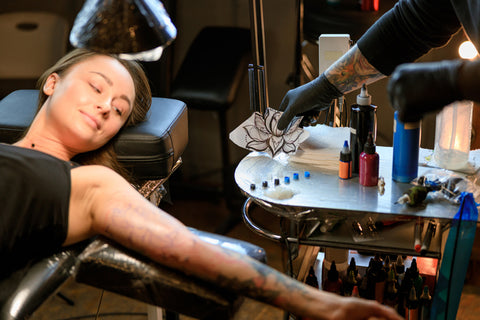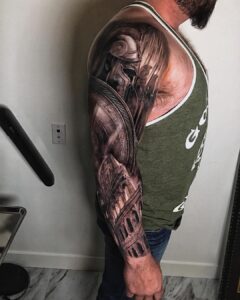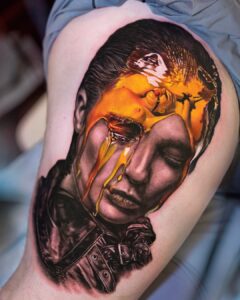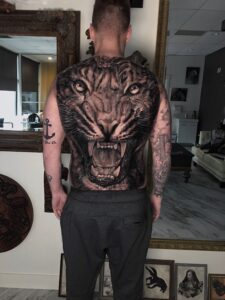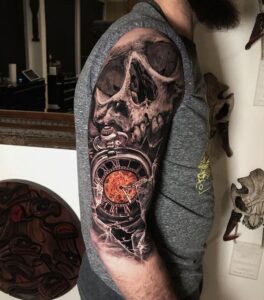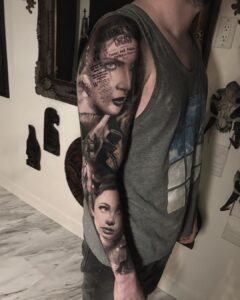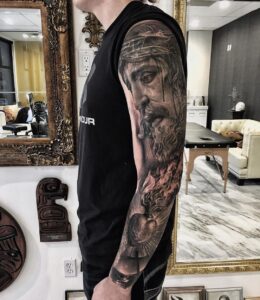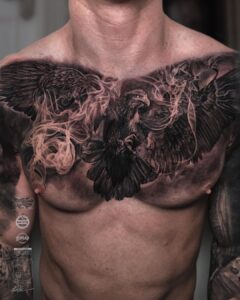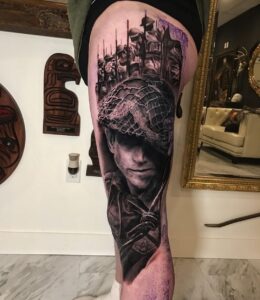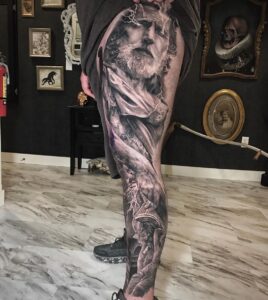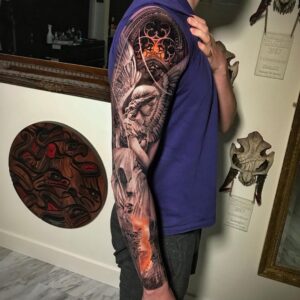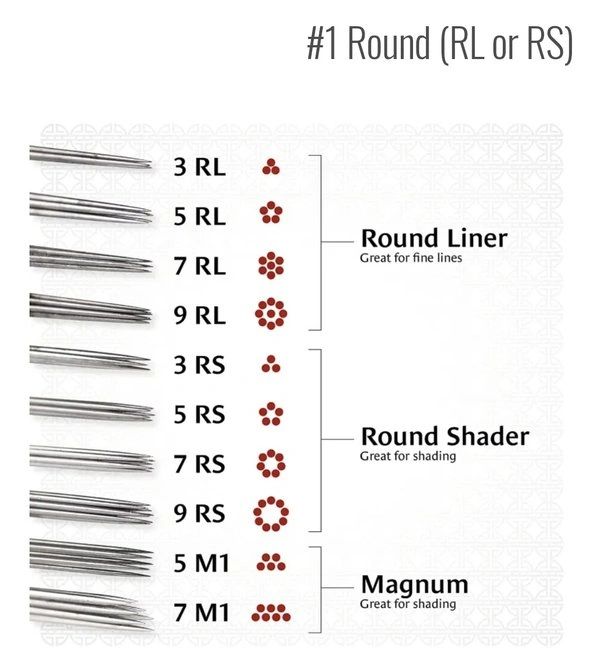
In recent years, it has become very popular to have neck tattoos, have you noticed that? It is a bold and expressive form of art; we all can notice that, but if you are thinking about getting a tattoo on your neck, you must collect this essential information first.
In this article, we will discuss everything you need to know about neck tattoos, from how to prepare for the tattooing process to aftercare and healing, as well as various design considerations. Then let’s get to it!
How To Prepare For A Neck Tattoo?
Whatever your design may be, preparing for a tattoo that will go on your neck is not an easy thing to do. Since the neck is an area that is easy to see, you should choose a design that reflects your character and fits your own life, both personal and professional, as well as the right tattoo placement.
Finding a neck tattoo artist is an important part of the preparation process. Look online and read reviews to check their technical training and stock portfolio. Be certain that their skills and style coincide with what you’re looking for.
Once you have found your perfect artist, schedule a consultation. At this meeting, you will be able to talk about your intended design, ask for input from the artist, and talk with them face to face. In preparing for a neck tattoo, don’t hold back from telling the artist your thoughts about it or from sharing concerns.
Does A Neck Tattoo Hurt?
Now let’s tackle an issue head-on: Does a neck tattoo hurt? It’s a personal thing, but generally, it should be noted that this area is sensitive with little fat and little muscle. This means that the tattooing process might be a bit more uncomfortable compared to other body parts.
However, many people who have had neck tattoos report that the unpleasant sensation isn’t strong. To help alleviate any discomfort you might feel, ask your tattoo artist about pain-relief treatments like taking breaks from the session or using creams to reduce sensitivity before getting started.
If you want to know more about this subject, feel free to check out our tattoo pain chart.
Aftercare And Healing
After your neck tattoo is finished, proper tattoo aftercare is essential for your skin to heal well and keep looking lively. Although your tattoo artist will give you all the instructions you need, here are some basic ideas:
- Keep the tattoo clean and dry for the first 24 hours.
- Avoid excessive sunlight and swimming until the skin has fully healed.
- Use a little unscented, hypoallergenic moisturizer so that your skin does not become too dry.
- Resist the urge to touch or scratch your tattoo. This can cause infection or slow down your body’s natural healing process.
- Follow any additional instructions given by your tattoo artist, such as avoiding certain clothing materials or sleeping positions.
And remember, a balanced, healthy diet, an appropriate amount of sleep, and proper skin care are all essentials as well.
Proper aftercare plays a vital role in the longevity and vibrancy of your neck tattoo, so be diligent in following the guidelines given to you.
Neck Tattoo Ideas And Design Considerations
When it comes to neck tattoo ideas, the sky’s the limit. There are, however, some design considerations that need to be taken into account so that your neck tattoo complements the shape and curves of your neck.
If you’d like something that’s not very noticeable and easy to conceal, you might consider small tattoo designs tailored for certain hairstyles or dress styles. On the other hand, if you want to make a bold statement, larger and more intricate neck tattoos may be the perfect choice for you.
Also, think about your existing body tattoos and how they relate to one another. Consider the makeup of their overall pattern and the way it flows, so your neck tattoo ideas also match.
Neck Tattoos For Men
Neck tattoos for men are a way to showcase their personality and individuality. Among the main designs of neck tattoos for men, geometric patterns, skull tattoos, animal motifs, tribal symbols, and lettering are common choices. Some even illustrate whole portraits in great detail. Each design carries its own unique meaning and can be tailored to reflect personal stories and values.
Neck Tattoos For Women
Neck tattoos for women can be a powerful form of self-expression and personal empowerment. Common designs of neck tattoos for women are often small floral designs or complex mandalas. Other favorite motifs include butterfly neck tattoos with delicate wings, eye tattoos, flying birds, and literary quotations. Furthermore, if they are strategically positioned, neck tattoos can frame that delicate neck area and enhance the shape you desire.
Types of Neck Tattoos
Neck tattoos come in many styles, and the choice will ultimately depend on your own tastes. Some popular styles include:
- Traditional tattoos with bold lines and vibrant colors.
- Realism tattoos capture intricate details and lifelike representations.
- Blackwork tattoos, utilizing bold black ink and intricate patterns.
- Watercolor tattoos, featuring vibrant rose tattoos and abstract designs with splashes of color.
You will see different options in different styles, and each has its own unique appeal. Try them all out and find the one that feels right for you!
Tattoos On The Front Of Your Neck
Front neck tattoos are certainly eye-catching and quite bold as well. Even though most employers no longer pay attention to tattoos as that’s an old-fashioned way of thinking, some places still consider them “unprofessional,” as unreal as that may sound nowadays!
On that same note, the potential impact on your professional life should also be considered, depending on your work field. Some workplaces might have policies against visible tattoos.
If you work in an environment where body art is allowed, front-neck tattoos can be a way to express your unique character and creativity.
Tattoos On The Side Of Your Neck
Side neck tattoos offer a balance between visibility and concealment, making them a popular choice among individuals who want the option to showcase or hide their tattoos. Script lettering, small symbols, or subtly patterned and delicate designs like these work especially well on the side of the neck as an attractive accent.
Tattoo On The Back Of The Neck
The back of the neck is widely used for tattoos because it is versatile and can be covered up easily. When designing your tattoo on the back of the neck, consider those that follow the natural curvature of the back spine in an unbroken line. This area is perfect for script tattoos as well as detailed mandalas or simple yet meaningful symbols.
Finding the Right Tattoo Artist
It is essential to choose the correct tattoo artist when you do your research. There are some neck tattoo artists with styles that match your own and perhaps some who don’t, and that’s okay! Also, don’t be afraid to ask around or even read customer reviews.
Once you have found possible candidates, book consultations with each of them so that you can discuss your ideas, ask questions, and review their professionalism. When considering a tattoo artist, you have to trust your gut since it is a personal choice. You can be sure to get your message across if you communicate openly all along the way.
Looking for a tattoo shop in West Covina? We’re here to help you!
Summarizing Paragraph
After all, neck tattoos are a brave form of body art that can give you the chance to express your creativity and the secret inside story. Remember, your neck is a canvas, and a tattoo there can be more than just decoration.
It can tell your story, mark a personal milestone, or simply be a bold statement of who you are. If you’re considering taking the plunge, do your research, find a reputable artist, and remember that aftercare is key to keeping that story vibrant for years to come. Who knows, maybe your next adventure starts with a needle and some ink!











